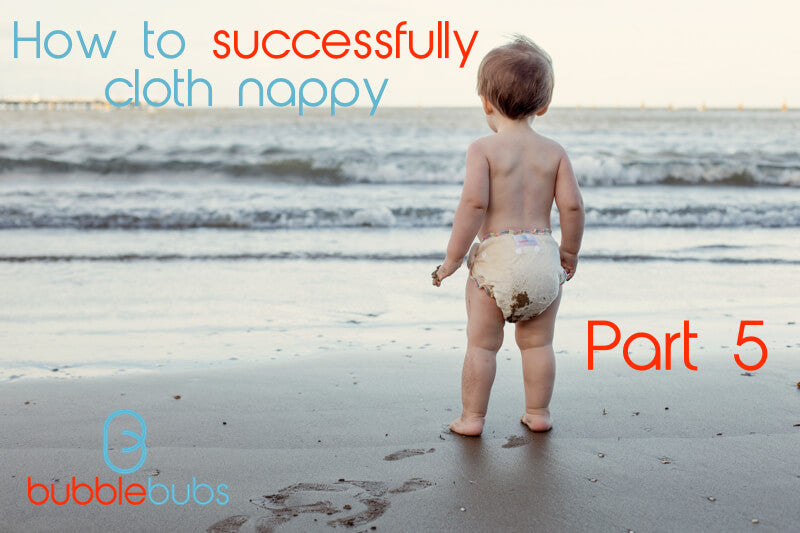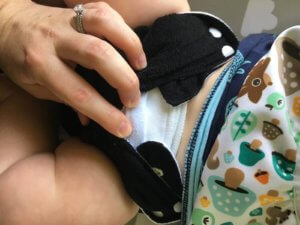
How to cloth nappy successfully - Part 5 Troubleshooting
Troubleshooting! Ok I’ll admit it’s not the sexiest topic or the most fun. But I was at the park with another mum one day and she was complaining about having to change her son’s bedding in the middle of the night “again!” and she turned to me and said “How annoying is it?”. I answered truthfully “Don’t know I’ve never done it”. I mean I assume it would be but I’ve been lucky I’ve never had a cot sheet destroying leak. And I put it all down to being an over-researcher, when I decided to do modern cloth nappies I did weeks of research but I've distilled all that down to a helpful guide for you. It’s not exciting but if you go in well researched and ready for diagnosing leaks and getting a great fit you too won’t be able answer my friend’s question!

Troubleshooting Leaks
We all hope for no leaks but let’s face it, when does parenting ever go how we hope? There are leaks, in cloth, in disposable at some points babies delightful gifts will escape. If you’re lucky it’ll be on your friend’s driveway (totally hypothetical and of course not a thing that actually happened to me). It’s a fact of parenting life but let’s see what we can do to keep it to an absolute minimum. Now we’re going to do a bit of detective work. To start with it’s easiest to divide leaks into two main categories.
If your inserts are soaked check:
- Absorbency: If there are leaks and the inserts are completely soaked boost absorbency or change more often (2-3 hours is ideal). If you’re using a Candy with just the trifold add the booster between the layers of the trifold. Or if you’re using a fitted nappy like a Bambam or a Bamboo delight you can place a booster between the nappy and the shell. This way you add absorbency without compromising your seal around the leg. We have two options for boosters, one with a microfleece topper and one without. It depends where you want to place it. If you want it against babies skin than the one with the stay-dry microfleece topper is great. If you want to boost outside the nappy this booster would be best.
- Compression: Compression leaks really only occur with microfibre inserts. Imagine a sponge, it can absorb a lot of water for it’s size but as soon as you apply pressure (like squeezing or bub sitting down) out comes all that moisture again. You can try a few things to remedy this: a looser nappy fit, bigger clothes or onesie extender. Or what would probably work best is switching to a different type of insert like bamboo or cotton.
If your inserts aren’t soaked check:
- Flooding: If they’re holding on and then peeing large volumes quickly they can flood their nappy before the bamboo can absorb it. In this case try a microfibre insert on top of a bamboo one, keeping in mind microfibre should never go against his skin so place in pocket or use a liner.
- Repelling: If they’re not doing really strong wees it can roll off the stay dry layer rather than soaking/pushing through; if a microfleece liner was used try it without, or try folding so you have bamboo material facing baby’s skin rather than the stay dry panel, or if you’re using a pocket nappy try laying inserts in the nappy instead of in the pocket. Alternatively, there might be build up of something coating the nappy and your wash routine might need adjusting.
- Fit: Fit is the big one! Getting the fit just right means inserts are flat and in the right place and elastics are creating a great seal around the legs. Keep reading for more information about getting a great fit.
Two more types of leaks to keep an eye out for:
- Penis position leaks: If you’re getting a leak straight out one side up or the belly and you have a little boy your first port of call should always be the penis. Always make sure that pesky thing is pointing down!
- Wicking: If an absorbent fabric touches something wet it will pull out moisture, check if an insert is poking out or his clothes are tucked into the nappy. With your Candies you always want to make sure that the side flaps are between the insert and the shell, not against the skin. (See photo for correct placement) As a note, onesies that settle in the underwear line can often wick.

Fit
The best thing for fit is watching fit videos. Watch generic ones, watch brand specific ones. Watch all the fit videos, you never know what you’ll see that will be the secret to cracking your perfect fit! And if you ask really really nicely and are just hormonal and pregnant enough you may even be able to cajole your husband/partner/baby daddy or mumma into watching them with you. No I didn’t make my husband spend a saturday night watching fit videos when I was 36 weeks pregnant… what would make you ask that?
Some general rules for getting the best fit with your cloth nappies:
- Low in the back: Should be lined up with the top of his bum crack, can be a little higher but not as high as a disposable would sit.
- Gussets in groin: Butterfly his legs up and out to make sure elastic sits in groin like underwear. This is very important for getting a good leg seal. Running your finger around the leg elastics will also do wonders for that seal.
- Pull up the front: Pull front panel up taught, it should look high on his belly at this point
- Up and over: Pull sides up and over his thighs in an arc, rather than straight across. This makes it easier to get a good seal around chubby thighs.
- Adjust: Wiggle back up if bum crack has slipped out. Should settle just below their belly button at the front
Check:
- Make sure all inner parts of fabric are tucked in.
- No leg gaps
- Not too tight on belly, move him into a sitting position to check.
- Make sure extra fabric from rise snaps (if there are any) is pushed up not down.
- You should be able to fit 2 fingers comfortably in the belly and 1 comfortably in legs. (As a side note: if you’re worried that when you take the nappies off there’s a red mark don’t get too stressed. As long as it goes away in under 30 minutes it’s fine, just like our underwear leaves a mark on our skin, it’s not causing any pain or discomfort).
If you’ve made it through all that you should be ready to fit a cloth nappy like a pro and suss out the cause of any leaks pretty easily! Once you’ve got this down cloth nappies will be a breeze and you’ll be able to smugly tell your disposable using friends how few leaks you get.
